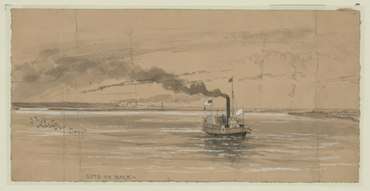Cartel (ship)
.jpg)
Cartel ships, in international law, are ships employed on humanitarian voyages, in particular, to carry communications or prisoners between belligerents. They fly distinctive flags, including a flag of truce. Traditionally, they were unarmed but for a signal gun.[1]
While serving as a cartel, a ship was not subject to capture. However, if it engaged in commerce or warlike acts such as carrying official dispatches or messengers, it lost its character of inviolability and would then be subject to capture. The cartel protection extended to the return voyage. Furthermore, the prisoners being taken for exchange were under an obligation not to engage in hostilities towards their captors. If they were to capture the cartel ship, they would have no rights to salvage, and the owner of the vessel, if it were a ship from their country, would have no right to reclaim the vessel.
During the War of 1812 the British Admiralty wrote to the United States Government that Great Britain would not accept as valid, cartel agreements made on the high seas. On 10 June 1813, USS President captured the outward-bound Falmouth packet Duke of Montrose, Captain Aaron Groub Blewett, which managed to throw her mails overboard before President could send a prize crew aboard. President made a cartel of Duke of Montrose, putting all of President's prisoners from three earlier captures, on board and then sending her and her now 79 passengers and crew into Falmouth under the command of an American officer. There the British government refused to recognize the cartel agreement that Blewett, his crew, and passengers had signed. Rather than turn Duke of Montrose over to the Agent for American Prisoners, the British government instructed Blewett to resume command of his ship and prepare her to sail again.[2]
The last known modern day use of the title 'cartel ship' refers to the SS Canberra, a British P&O cruise liner that the UK used in 1982 in the Falkland Islands War. Known colloquially as 'The Great White Whale', Canberra ferried 4,000 Argentinian prisoners of war from the islands to Puerto Madryn, Argentina, from East Falkland after the cessation of hostilities, and was appointed a cartel ship by the Red Cross representative Hugo Berchtold, then present in the islands.

Citations and references
Citations
- ↑ Cartel flags, Joe McMillan, 14 December 2001, https://www.crwflags.com/fotw/flags/xf-crtl.html
- ↑ Dudley (1985), pp.157-9.
References
- Dudley, William S. (1985) The Naval War of 1812: A Documentary History. (Government Printing Office). ISBN 978-0945274063
- Maxey, Edwin (1906) International law with illustrative cases. (F.H. Thomas Law Book Co.), p.500.
- Upton, Francis Henry (1863) The law of nations affecting commerce during war: with a review of the jurisdiction, practice and proceedings of prize courts. (J.S. Voorhies), pp.25-27.